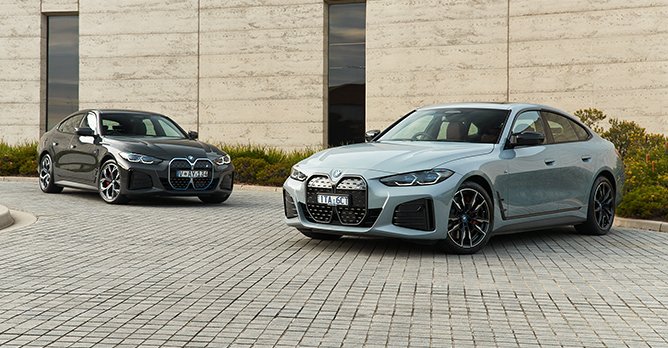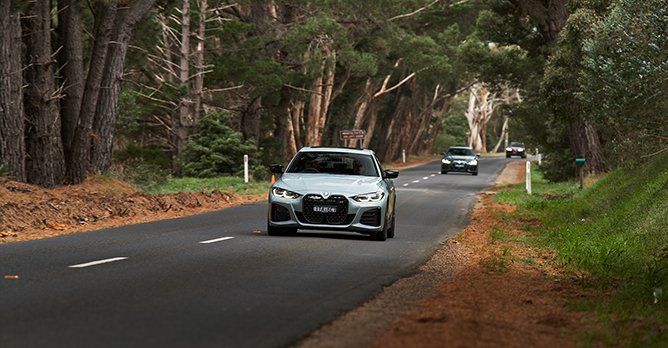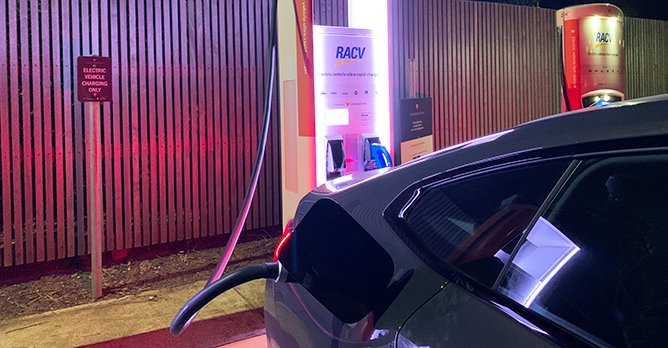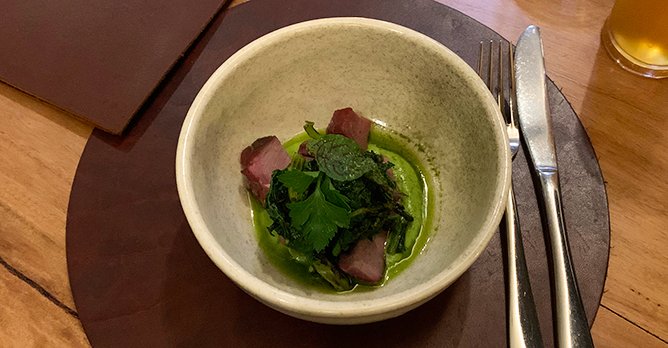An electric road trip Down Under to take stock of the transforming future
20 May 2022|1,189 views
Melbourne roads are shockingly straight. And it's not just the grid-based urban planning in the city centre, either. Outside the city of Melbourne in the more rural parts of the state of Victoria, many of the roads (even the small, two lane roads) are literal straight shots, kilometres at a time.
Just as well, then, that I'm driving cars that can easily eat up mile after mile of what appears to be very well-maintained and smooth Aussie tarmac.
Up front
I'm in Melbourne on a little road trip, driving a pair of i4s - the standard i4 eDrive40, as well as the i4 M50.
These are exciting cars - not just in how they perform in the present day, but also what they set up for the future. We know that electrification is the way forward for the automotive industry, and the i4 exemplifies what premium motoring can and will be.
With effortless pace and excellent comfort, the i4 eDrive40 delivers ample cruising delight. It can carry plenty of speed, obviously, but more importantly it is the serenity of which it can swallow up mile after mile of tarmac that is most impressive. And, you can even turn on the Assisted Driving function and let the car do most of the driving for you (though your hands have to be on the wheel, of course). And on the long straight roads in Victoria, I must admit to enjoying this i4 more.
The i4 M50 is a step up in terms of performance. There's monstrous pace - the car rockets off into the distance with just the slightest stab of the throttle. Through windy roads, it's also more dynamic and aggressive, with four-wheel drive allowing you to power out of corners shockingly early.
Admittedly, the relatively flat topography of the area that we are in means that windy mountain roads are uncommon, but you don't just need switchback roads to appreciate the M50. On the highway, I am thankful that it feels much less tiresome than I would traditionally expect in an M car.
Not quite out back
Considering I was last in Australia some 25 years ago, I don't have many memories of what the place was like back then. However, in 2022, you can definitely tell that it's a place that's looking at a future with improved sustainability in mind.
From an automotive perspective, that means more EVs, and thus the need for a more extensive charging architecture as well. And considering that the hotel we were at had two ultra-rapid chargers that have a charging rate of over 350kW, the charging capability right now definitely already far outpaces Singapore's (and most EVs, actually).
What does this mean for travellers, then? Can you, or should you road trip in an EV? Well, with a little extra planning, you definitely can. It doesn't take that much effort to Google the locations of various charging stations. Hell, there are probably a bunch of apps that already do that.
And it's not just Australia, either. As we've also experienced, charging infrastructure in many countries are rapidly improving. Across Europe, rapid charging stations can also be found along expressways.
You could make the case that this is also a function of other countries being significantly bigger than Singapore - charging infrastructure is just necessary to accommodate the long distances that drivers have to cover.

 We're increasingly seeing more restaurants embrace sustainably-sourced ingredients, both overseas and in Singapore Should you? For the sake of our environment, you probably should. But perhaps more notably, you may not actually have a choice in the near future. As more brands transition towards EVs, the option to not drive an EV may not even be available anymore.
We're increasingly seeing more restaurants embrace sustainably-sourced ingredients, both overseas and in Singapore Should you? For the sake of our environment, you probably should. But perhaps more notably, you may not actually have a choice in the near future. As more brands transition towards EVs, the option to not drive an EV may not even be available anymore.
Beyond just cars though, the push for more sustainable living is evident elsewhere as well. For example, a few of the restaurants we dined at also celebrate sustainability. One of them, Mabu Mabu, uses indigenous ingredients, which means we got to taste unusual (for us) yet unique ingredients like sunflower root and karkalla, as well as crocodile meat, kangaroo tail and emu. Because, you know, Australia. Another restaurant, Farmer's Daughter, has a seasonal menu that uses ingredients sourced from the Gippsland region in Australia.
This push for better food sustainability is something we're seeing in Singapore as well. From high-tech hydroponic farms to urban rooftop gardens, as well as restaurants that prioritise local ingredients and minimal waste, there is increasing recognition for the need to reduce our carbon footprint across all aspects of our lives.
Maybe drivers haven't fully bought into the electric future of mobility, but the need to reduce emissions affects us in every aspect of our lives, and not just our cars. This short road trip in Australia has shown me that this transformation is already happening. And we can at least take heart in knowing that the cars, like everything else, are already improving and transforming to ensure that this transition happens seamlessly, but perhaps more importantly, quickly.
Just as well, then, that I'm driving cars that can easily eat up mile after mile of what appears to be very well-maintained and smooth Aussie tarmac.
Up front
I'm in Melbourne on a little road trip, driving a pair of i4s - the standard i4 eDrive40, as well as the i4 M50.
These are exciting cars - not just in how they perform in the present day, but also what they set up for the future. We know that electrification is the way forward for the automotive industry, and the i4 exemplifies what premium motoring can and will be.
With effortless pace and excellent comfort, the i4 eDrive40 delivers ample cruising delight. It can carry plenty of speed, obviously, but more importantly it is the serenity of which it can swallow up mile after mile of tarmac that is most impressive. And, you can even turn on the Assisted Driving function and let the car do most of the driving for you (though your hands have to be on the wheel, of course). And on the long straight roads in Victoria, I must admit to enjoying this i4 more.
The i4 M50 is a step up in terms of performance. There's monstrous pace - the car rockets off into the distance with just the slightest stab of the throttle. Through windy roads, it's also more dynamic and aggressive, with four-wheel drive allowing you to power out of corners shockingly early.
Admittedly, the relatively flat topography of the area that we are in means that windy mountain roads are uncommon, but you don't just need switchback roads to appreciate the M50. On the highway, I am thankful that it feels much less tiresome than I would traditionally expect in an M car.
Not quite out back
Considering I was last in Australia some 25 years ago, I don't have many memories of what the place was like back then. However, in 2022, you can definitely tell that it's a place that's looking at a future with improved sustainability in mind.
From an automotive perspective, that means more EVs, and thus the need for a more extensive charging architecture as well. And considering that the hotel we were at had two ultra-rapid chargers that have a charging rate of over 350kW, the charging capability right now definitely already far outpaces Singapore's (and most EVs, actually).
What does this mean for travellers, then? Can you, or should you road trip in an EV? Well, with a little extra planning, you definitely can. It doesn't take that much effort to Google the locations of various charging stations. Hell, there are probably a bunch of apps that already do that.
And it's not just Australia, either. As we've also experienced, charging infrastructure in many countries are rapidly improving. Across Europe, rapid charging stations can also be found along expressways.
You could make the case that this is also a function of other countries being significantly bigger than Singapore - charging infrastructure is just necessary to accommodate the long distances that drivers have to cover.

Beyond just cars though, the push for more sustainable living is evident elsewhere as well. For example, a few of the restaurants we dined at also celebrate sustainability. One of them, Mabu Mabu, uses indigenous ingredients, which means we got to taste unusual (for us) yet unique ingredients like sunflower root and karkalla, as well as crocodile meat, kangaroo tail and emu. Because, you know, Australia. Another restaurant, Farmer's Daughter, has a seasonal menu that uses ingredients sourced from the Gippsland region in Australia.
This push for better food sustainability is something we're seeing in Singapore as well. From high-tech hydroponic farms to urban rooftop gardens, as well as restaurants that prioritise local ingredients and minimal waste, there is increasing recognition for the need to reduce our carbon footprint across all aspects of our lives.
Maybe drivers haven't fully bought into the electric future of mobility, but the need to reduce emissions affects us in every aspect of our lives, and not just our cars. This short road trip in Australia has shown me that this transformation is already happening. And we can at least take heart in knowing that the cars, like everything else, are already improving and transforming to ensure that this transition happens seamlessly, but perhaps more importantly, quickly.
Melbourne roads are shockingly straight. And it's not just the grid-based urban planning in the city centre, either. Outside the city of Melbourne in the more rural parts of the state of Victoria, many of the roads (even the small, two lane roads) are literal straight shots, kilometres at a time.
Just as well, then, that I'm driving cars that can easily eat up mile after mile of what appears to be very well-maintained and smooth Aussie tarmac.
Up front
I'm in Melbourne on a little road trip, driving a pair of i4s - the standard i4 eDrive40, as well as the i4 M50.
These are exciting cars - not just in how they perform in the present day, but also what they set up for the future. We know that electrification is the way forward for the automotive industry, and the i4 exemplifies what premium motoring can and will be.
With effortless pace and excellent comfort, the i4 eDrive40 delivers ample cruising delight. It can carry plenty of speed, obviously, but more importantly it is the serenity of which it can swallow up mile after mile of tarmac that is most impressive. And, you can even turn on the Assisted Driving function and let the car do most of the driving for you (though your hands have to be on the wheel, of course). And on the long straight roads in Victoria, I must admit to enjoying this i4 more.
The i4 M50 is a step up in terms of performance. There's monstrous pace - the car rockets off into the distance with just the slightest stab of the throttle. Through windy roads, it's also more dynamic and aggressive, with four-wheel drive allowing you to power out of corners shockingly early.
Admittedly, the relatively flat topography of the area that we are in means that windy mountain roads are uncommon, but you don't just need switchback roads to appreciate the M50. On the highway, I am thankful that it feels much less tiresome than I would traditionally expect in an M car.
Not quite out back
Considering I was last in Australia some 25 years ago, I don't have many memories of what the place was like back then. However, in 2022, you can definitely tell that it's a place that's looking at a future with improved sustainability in mind.
From an automotive perspective, that means more EVs, and thus the need for a more extensive charging architecture as well. And considering that the hotel we were at had two ultra-rapid chargers that have a charging rate of over 350kW, the charging capability right now definitely already far outpaces Singapore's (and most EVs, actually).
What does this mean for travellers, then? Can you, or should you road trip in an EV? Well, with a little extra planning, you definitely can. It doesn't take that much effort to Google the locations of various charging stations. Hell, there are probably a bunch of apps that already do that.
And it's not just Australia, either. As we've also experienced, charging infrastructure in many countries are rapidly improving. Across Europe, rapid charging stations can also be found along expressways.
You could make the case that this is also a function of other countries being significantly bigger than Singapore - charging infrastructure is just necessary to accommodate the long distances that drivers have to cover.

 We're increasingly seeing more restaurants embrace sustainably-sourced ingredients, both overseas and in Singapore Should you? For the sake of our environment, you probably should. But perhaps more notably, you may not actually have a choice in the near future. As more brands transition towards EVs, the option to not drive an EV may not even be available anymore.
We're increasingly seeing more restaurants embrace sustainably-sourced ingredients, both overseas and in Singapore Should you? For the sake of our environment, you probably should. But perhaps more notably, you may not actually have a choice in the near future. As more brands transition towards EVs, the option to not drive an EV may not even be available anymore.
Beyond just cars though, the push for more sustainable living is evident elsewhere as well. For example, a few of the restaurants we dined at also celebrate sustainability. One of them, Mabu Mabu, uses indigenous ingredients, which means we got to taste unusual (for us) yet unique ingredients like sunflower root and karkalla, as well as crocodile meat, kangaroo tail and emu. Because, you know, Australia. Another restaurant, Farmer's Daughter, has a seasonal menu that uses ingredients sourced from the Gippsland region in Australia.
This push for better food sustainability is something we're seeing in Singapore as well. From high-tech hydroponic farms to urban rooftop gardens, as well as restaurants that prioritise local ingredients and minimal waste, there is increasing recognition for the need to reduce our carbon footprint across all aspects of our lives.
Maybe drivers haven't fully bought into the electric future of mobility, but the need to reduce emissions affects us in every aspect of our lives, and not just our cars. This short road trip in Australia has shown me that this transformation is already happening. And we can at least take heart in knowing that the cars, like everything else, are already improving and transforming to ensure that this transition happens seamlessly, but perhaps more importantly, quickly.
Just as well, then, that I'm driving cars that can easily eat up mile after mile of what appears to be very well-maintained and smooth Aussie tarmac.
Up front
I'm in Melbourne on a little road trip, driving a pair of i4s - the standard i4 eDrive40, as well as the i4 M50.
These are exciting cars - not just in how they perform in the present day, but also what they set up for the future. We know that electrification is the way forward for the automotive industry, and the i4 exemplifies what premium motoring can and will be.
With effortless pace and excellent comfort, the i4 eDrive40 delivers ample cruising delight. It can carry plenty of speed, obviously, but more importantly it is the serenity of which it can swallow up mile after mile of tarmac that is most impressive. And, you can even turn on the Assisted Driving function and let the car do most of the driving for you (though your hands have to be on the wheel, of course). And on the long straight roads in Victoria, I must admit to enjoying this i4 more.
The i4 M50 is a step up in terms of performance. There's monstrous pace - the car rockets off into the distance with just the slightest stab of the throttle. Through windy roads, it's also more dynamic and aggressive, with four-wheel drive allowing you to power out of corners shockingly early.
Admittedly, the relatively flat topography of the area that we are in means that windy mountain roads are uncommon, but you don't just need switchback roads to appreciate the M50. On the highway, I am thankful that it feels much less tiresome than I would traditionally expect in an M car.
Not quite out back
Considering I was last in Australia some 25 years ago, I don't have many memories of what the place was like back then. However, in 2022, you can definitely tell that it's a place that's looking at a future with improved sustainability in mind.
From an automotive perspective, that means more EVs, and thus the need for a more extensive charging architecture as well. And considering that the hotel we were at had two ultra-rapid chargers that have a charging rate of over 350kW, the charging capability right now definitely already far outpaces Singapore's (and most EVs, actually).
What does this mean for travellers, then? Can you, or should you road trip in an EV? Well, with a little extra planning, you definitely can. It doesn't take that much effort to Google the locations of various charging stations. Hell, there are probably a bunch of apps that already do that.
And it's not just Australia, either. As we've also experienced, charging infrastructure in many countries are rapidly improving. Across Europe, rapid charging stations can also be found along expressways.
You could make the case that this is also a function of other countries being significantly bigger than Singapore - charging infrastructure is just necessary to accommodate the long distances that drivers have to cover.

Beyond just cars though, the push for more sustainable living is evident elsewhere as well. For example, a few of the restaurants we dined at also celebrate sustainability. One of them, Mabu Mabu, uses indigenous ingredients, which means we got to taste unusual (for us) yet unique ingredients like sunflower root and karkalla, as well as crocodile meat, kangaroo tail and emu. Because, you know, Australia. Another restaurant, Farmer's Daughter, has a seasonal menu that uses ingredients sourced from the Gippsland region in Australia.
This push for better food sustainability is something we're seeing in Singapore as well. From high-tech hydroponic farms to urban rooftop gardens, as well as restaurants that prioritise local ingredients and minimal waste, there is increasing recognition for the need to reduce our carbon footprint across all aspects of our lives.
Maybe drivers haven't fully bought into the electric future of mobility, but the need to reduce emissions affects us in every aspect of our lives, and not just our cars. This short road trip in Australia has shown me that this transformation is already happening. And we can at least take heart in knowing that the cars, like everything else, are already improving and transforming to ensure that this transition happens seamlessly, but perhaps more importantly, quickly.
Thank You For Your Subscription.


































